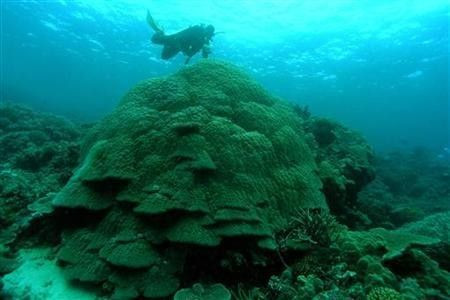Marine Reserves And Fishing Control Prove Beneficial For The Great Barrier Reef And The Fishing Industry

Researchers recently discovered the greatest difference between marine reserves and fishing areas in relation to the status of the Great Barrier Reef. The journal Current Biology published a monitoring study conducted for 30 years by the Australian Institute of Marine Science and James Cook University, which suggests that previous efforts to decrease fishing in the Great Barrier Reef is exhibiting great results.
When fishing was banned in around a third of the Great Barrier Reef Marine Park in 2004, the researchers had the perfect opportunity to compare the status of the corals since the 1980s and the present. The team, led by Dr David Williamson of the ARC Centre of Excellence for Coral Reef Studies at James Cook University, reports that the major difference of the marine life between then and now is the size of the coral trout.The average biomass of the coral trout is found to be 2.5 times higher in the marine controlled reserves than in the fished regions, and Williamson said that if there was no poaching on the reef, it could be higher.
The overall health and status of the reef is not affected by the separation of the areas. WIlliamson also adds that the fishery methods are not at all damaging to the reef. This finding is completely opposite with the expectations that fishing on coral reefs may have damaging effects on the corals and other water organisms. Furthermore, the larger coral trout were said to survive Tropical Cyclone Hamish in 2009 excellently.
Some groups have expressed their concerns about a possible “squeeze effect” that the establishment of the marine reserves may create. The “squeeze effect” pertains to the concentration of fishing activities in the free areas, and thus may cause increased pressure to that area. But Williamson confirmed that there was no significant change in the amount of coral trout in the fished areas before and after the programme. He credits this effect to the catch limits implemented by the industry, together with the creation of the reserves. Williamson also mentioned that the migration of coral trout larvae from non-fishing to fishing areas may have added benefits for the fishing industry. "Those fish populations in the areas that are closed are forming really valuable breeding populations and that's also contributing to what we call 'recruitment' in the areas that are open to fishing," he says.
A conservation biologist from the University of Tasmania, Dr. Neville Barrett, comments, "The work here is very, very heartening because it's actually showing that the integrated management involving the Great Barrier Reef Marine Park Authority, and Commonwealth state and fisheries agencies, is doing a really great job. It's great to see such a good independent endorsement of fishery work." However, he expressed doubts as to the surety of the coral trout larvae to develop fully, and hence benefit fisheries. He adds that it is very difficult to determine the vague areas of the process that can halt the population of the species.
Nonetheless, Williamson said the marine reserves are decent assurances for the fishing industry, particularly in developing countries where it is very difficult to establish size and catch limits. He also emphasised the ease of the programme’s implementation. Apart from fishing, the researchers said that the reef has to undergo several threats to its health and wellbeing like pollution, climate changes, and other coastal developments.
To contact the writer, email rinadoctor00@gmail.com





















